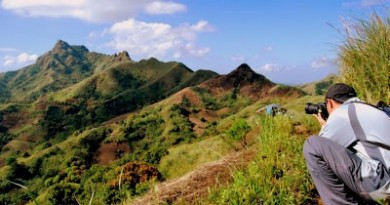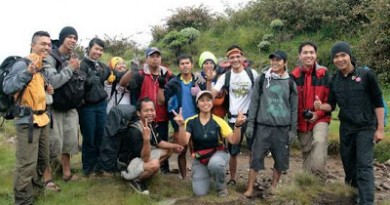by Gideon Lasco
For many years now, the collection and payment of registration fees has emerged as a contentious issue for hikers. Now, with the emergence of hiking as a mainstream recreational activity of the Philippines, the urgency of dealing with this has also emerged.
The case of Mt. Apo remains a strong example of how unregulated and disorganized authorities have led to the spiraling of costs – and a Mt. Apo traverse now costs over a thousand pesos, in registration fees alone. Considering that thousands of hikers climb Mt. Apo every year, where does all this money go? As hikers who are the source of money, and as taxpayers, who are the supposed beneficiary of government funds, we have the right to demand accountability and transparency.
It will also be remembered that Mt. Arayat was once a big turn-off to hikers because of the exorbitant fees imposed by the people at the Mt. Arayat National Park area. Until now, Arayat remains not-so-popular among hikers partly because of its unsavory past.
Moreover, there is also the issue of who are legally authorized to collect fees. There are many informal “caretakers” who collect fees without receipts or authorization from the local government; they earn a lot every weekend without any form of regulation or accounting. Some of these local caretakers claim that they indeed are working hard to maintain the mountain, and perhaps in some instances, their claims are credible. However, in other cases, setting up a registration area and a logbook has become more of a money-making activity.
How shall we deal with these? First, we need a set of guidelines by which we can evaluate the validity of a registration area. For a registration fee to be valid, the following parameters must be considered:
(1) Authority. Does the fee collector have the legal authority to make the collection? Under what authority are they doing the collection? If the mountain is on private property, the caretaker must represent the owner. If it’s public property, is there a PAMB directive, a municipal ordinance, or any government-issued document that backs up this authority?
(2) Transparency. Are receipts provided? Are contact numbers, addresses, and names of persons provided? Is there a breakdown of where the money goes? Of course there are some instances where receipts are not available, and this is understandable. But, especially when the registration fee exceeds P50, receipts become more of a requirement.
(3) Fairness. Even if there are receipts, are the fees collected reasonable and affordable? Are they fair considering what is being offered to the hikers? Of course, it is hard to quantify “fairness” but a reasonable measure of fairness would be to compare the mountain in question with other mountains of similar nature.
(4) Accountability. The collecting authority must be accountable to the stakeholders in the mountain (the environment, the local communities, and to the mountaineering community). Are the fees collected benefiting these stakeholders? Do they provide the services that the promise, including policing and taking good care of the mountain? Can they be depended on in case there is a need for help in the mountains?
We demand that all these four principles be met and observed by all collecting authorities in all entry points in all mountains in the Philippines, and urge all concerned to help us in this ensuring that these principles are met, for the benefit of all involved, including the environment and the local communities.
These demands cannot be met by disobedience, or by refusing to pay these fees. We would like to still place our trust in the government, and thus, our recommended form of clamor is to raise the issue to higher authorities, such as the DENR or the LGU concerned. Another way of clamoring is by telling the locals that many hikers are avoiding the place because of the costs. Also, raising the issues in public arenas, including the Internet, will be helpful. Most local governments also have their eyes and ears online and hopefully, they would listen.
There is nothing wrong about locals earning money from hikers. In fact, to some extent, it can be argued that they deserve some benefit from the hiking activity that somehow affects their lives as well. What we are arguing for is a fair and transparent collection of fees that are reasonable.
Subang Jaya, Malaysia
June 17, 2012




Leave a Reply
6 Comments on "Essay: Position paper on registration fees at entry points"
It's high time the issue on the collection of exorbitant fees in Mt Apo was addressed. Mt Apo is a sick old man. And its disease is spreading throughout all its facets. It might take a long time to heal this old man. The DOT and DENR can only implement whatever resolution they come up with down to the LGU level but they cannot easily control the greedy locals living in the foot of Mt Apo. Unlike Mt Pulag which is supervised only by one PaSu, three or more units claim rightful 'authority' (to profit) in Mt Apo. The authorities in Kidapawan cannot stop the annual increase of the already very high entrace fee of Digos. In Sibulan, they charge the same fees but no exit fee is strictly imposed (unlike in Kidapawan and Digos). But the local porters organization in Sibulan require all climbers to hire a porter/s, otherwise, they'll have to pay a compulsory per-head porter fee which can sometimes be higher than when you actually hire one. And neither Digos, Sibulan and Kidapawan can stop these local porters.
The Kapatagan (Digos) trail is the most notorious. I heard of an incident where a group of climbers were stopped and forced to get off their chartered van (from Davao) and was required to hire a habal-habal (one per person) to exit the mountain.
And you're right Gid. Disobedience is not an answer. And boycotting isn't the best gameplan either. We have the right to visit any public place in the country. And we are willing to pay the fees if they go to where they should be and it is reasonable. Ano kaya kung singilin din sa Metro Manila ang mga hindi taga-Metro ng entrance at exit fees? P650 kada pasok sa bawat lungsod sa metro manila at P650 din kada exit? nasaan ang lohika at hustisya dun?
I do agree with the article. The DENR and DOT should deputize the Baranggay Officials to man every entry points, and to issue government receipts. Tarak Ridge is one also one of the examples. Although very minimal, you have to pay both in the baranggay office and in one bahay kubo by the trail. I already personally told the baranggay office about it but since I haven't returned lately, I don't know if there has been actions taken.
I fully agree. Some of these collectors, whether barangay officials or resident-caretakers of the mountains, just maintain a logbook for their cash collections.
At least in Mt. Tarak they issue an Official Receipt for P40/reg. fee. In Mt. Pulag, I guess the Php 200 fee/climber by DENR is reasonable, and the guide/porter fees are consistent.
But in Mt. Apo, why do traversing climbers have to pay exit fee, aside from entrance fee? May scheduled climb pa naman kami ng group ko doon by April 2013.
I don't know how this blog really came to a very time cause. We were suppose to act on something that deals with transparency and accountability in Mt. Apo considering that it collects a somewhat huge amount of registration fee but you cant merely see any improvements within the area, specifically in terms of waste management. In this case, we need to cite Mt. Pulag as one of the best natural parks. It only cost 250 pesos for the registration, and yet the area is clean and organized,comparing with Mt. Apo who collects 650 pesos worth of registration fee in one trail only but the garbage is everywhere (along trails, campsites, water source etc). I know, we speak responsible mountaineering here, but what are these registration fees are for? San ba papunta yong 650 natin?
Mindanaoan moutaineers sometimes think about closing Mt. Apo temporarily to address this issue. Maybe the funds that DENR are generating should be used in restoring Mt. Apo in such a long-term manner.
We call for CLOSE APO MOVEMENT among fellow mountaineers.
Responsible mountaineering should also come with transparent management of our natural parks.
Dabawenyang Gala
i am in full agreement with what you wrote in your essay. Registrations fees are collected at very high cost, but there doesn't seem to be any accountability as to where these funds go to for the maintenance of mountains like Mt. Apo. Registration fees are supposed to regulate the number of climbers going up the mountains in order to protect it. It has however, become a money makingg scheme for the local tourism industry, with very little benefit visible for the protection on the mountains. I believe that the DENR and the Department of Tourism should come up with better regulations, one that is more protective and uniform for all. Take Mt. Apo…. you have one regulation on the registration fee in kidapawan, and another in Davao…. each one trying to compete to get the highest number of registrants of climbers.